Homepage » Council House – Henry Wilson
Henry Wilson – the all round artist for Coventry Council House
When the Coventry Society created the Public Art Trail for Civic Day 2016, we had very little knowledge about the sculpture associated with the Council House. We were aware that the main sculpture in white Portland stone had been done Henry Wilson and that was all that we knew. However, further research has established that Henry Wilson was an amazing all-round artist. He began his career as a Architect and became a great sculptor, metalworker and jeweller.
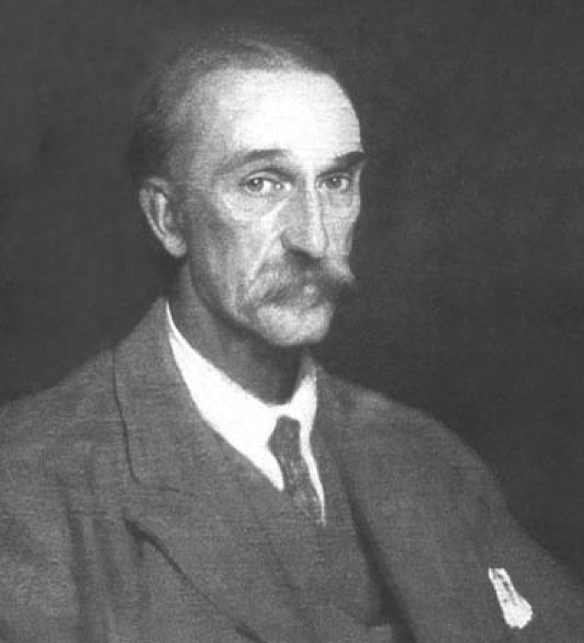
Henry Wilson was a modest, quiet man. He found it difficult to talk about his own work and most of his work went unsigned. In the Arts and Crafts circle at the time he was described in 1899 by C. R. Ashbee as – “looking like a seedy bank clerk, but perhaps the greatest artist of the lot”. Ashbee also bemoaned the fact that England “wasted” Wilson’s talent. Most of his great works were done abroad in Europe and America.
Henry Wilson was born on 12th March 1864 at 91 Red Rock Street, West Derby, Liverpool. His father was a headmaster and keen artist and encouraged his three sons to be also. Both of his parents were intensely religious but keen on debate and enquiry. (Henry’s father and brother did help him with some commissions, his father William helped on the Altar cross for St. Martin’s, Marple in 1896, and on the beaten brass doors of St. Peter’s Ealing. His brother Patten helped on the font for the chapel at Welbeck Abbey.)
Henry trained as a Architect; he became articled to the Maidenhead architect Edward Shewsbury who liked on-site supervision of his designs. Wilson’s philosophy of architecture was that the exchange of ideas between workman and architect was vital. In 1884 at the age of twenty he moved to London to work with John Oldrid Scott, Sir George Gilbert Scott’s son. It was here he learned a thorough professional grasp of all trades and skills that contributed to a building’s overall effect.
Two years later he moved to John Bletcher architects. There, working with T. P. Figgis, they entered and won a design competition for the Free Library, Ladbroke Grove, London. It had a ‘Tree of Knowledge’ designed to be carved in stone to symbolise the building’s purpose. It was to be flanked on each side by two large windows and the top of the tree would open out making arches with famous figures from literature like Milton, Shakespeare and Spenser. Unfortunately when it was built, costs had to be, the fine detail was cut and it ended up with no Tree!
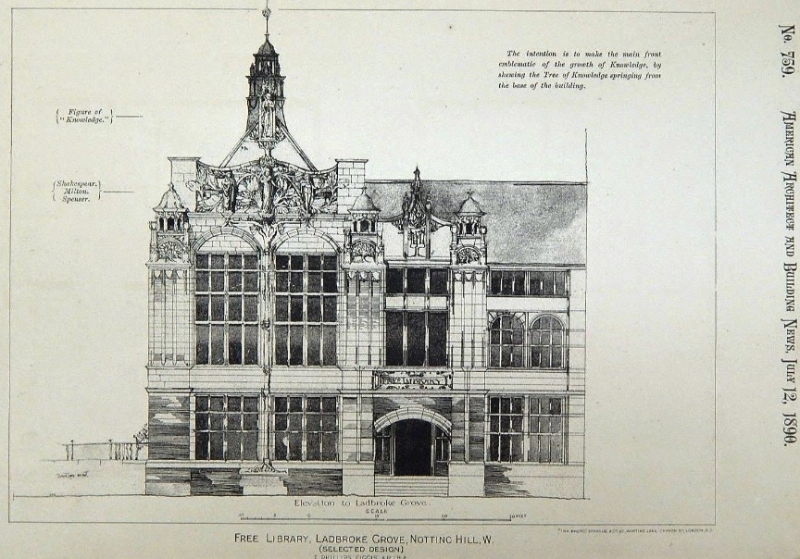
The Design for the Free Library
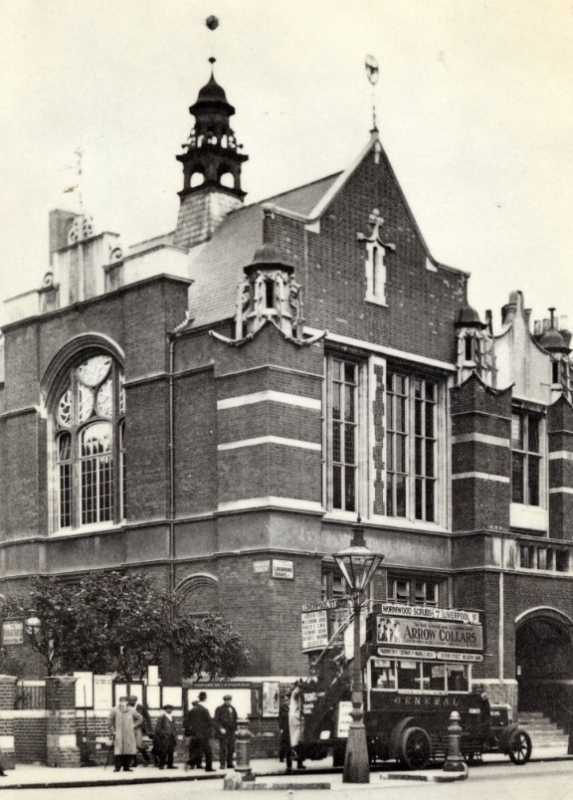
The finished Free Library without the ‘Tree of Knowledge’
In 1888 Henry moved again and joined John Dando Sedding, Oxford Street. Henry worked with Sedding on many churches, including Holy Trinity Church, Sloane Street, London. Unfortunately Seddings died at the age of 53 in 1891.
Hebert then had a creative transition from architect to craft worker, making bronze Altar crosses and candlesticks. He distinguished himself as a silversmith and jeweller. He was driven to make the best of his ability when he got the commission to make the tomb of Bishop William Elphinstone, the founder of the Aberdeen University. He moved his family, his wife and three daughters to Venice so that he could work in the studio modelling his design and working with the best bronze workers of the day and for it to be cast in Munaretti’s nearby foundry. His work was very detailed. He wanted to create the greatest work possible, but the outbreak of the First World War in 1914 meant he had to hide the work beneath the water of the canal as it would otherwise be melted down for the war effort. He brought his family back to England had to wait until the end of the War before he could get the work out of the canal. He finished it in 1926 – it was over sized and over budget by the end.
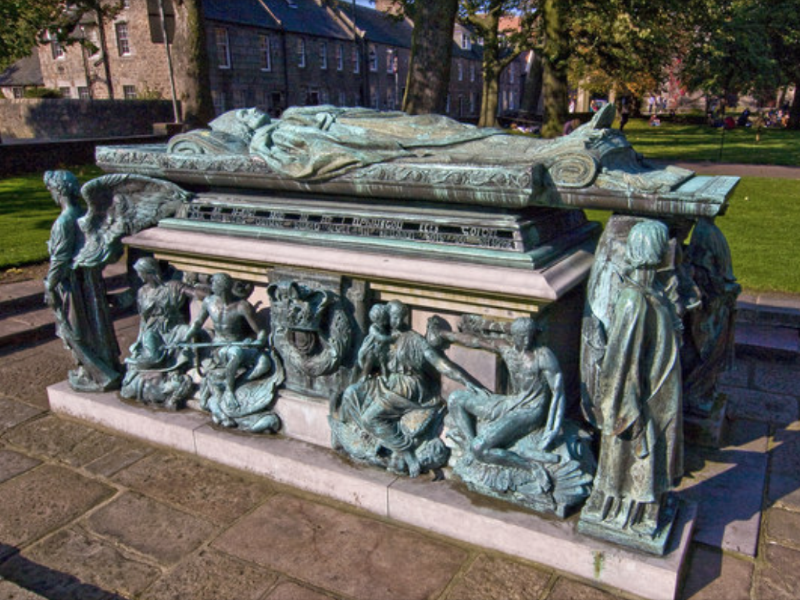
When he fled back to England he got the job in Coventry. The Council House was the result of a competition held in 1910, to match the style of St. Mary’s Hall and the Police Station in Bayley Lane. It was won by Birmingham architects Edward Garratt and H. W. Simister. Henry Wilson was to enrich both the inside and out. His involvement did not start until 1915. Inside Wilson took charge of furnishing and embellishing the first-floor Council Chamber. Outside, he adorned all three storeys of the entrance bay.
In 1915 he was climbing the scaffolding to inspect the possible sitting of one of his stone sculptures when he was overcome by searing pains and was narrowly saved from falling. He had to be carried down and rushed to hospital, desperately ill with a stomach ulcer aggravated by exhaustion.
He dressed the Hay Lane tower with shields of civic office and carved the four patron saints of the British Isles, keeping watch over the city. On the other corner of St Mary’s Street, jutting out of the tower, he designed a cantilevered clock with the swept back wings of a golden Angel. The original clock had a seven foot copper disc face but this was damaged in the Blitz and was replaced with white glass with a light behind it.
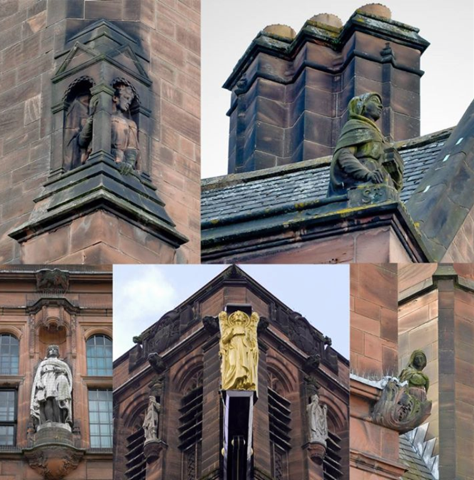
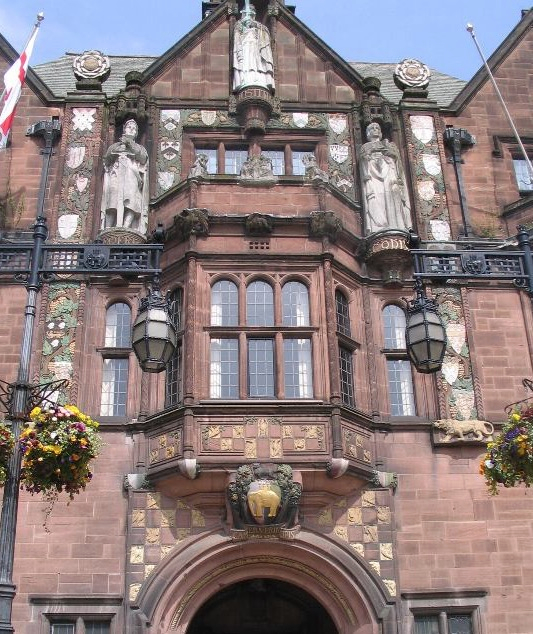
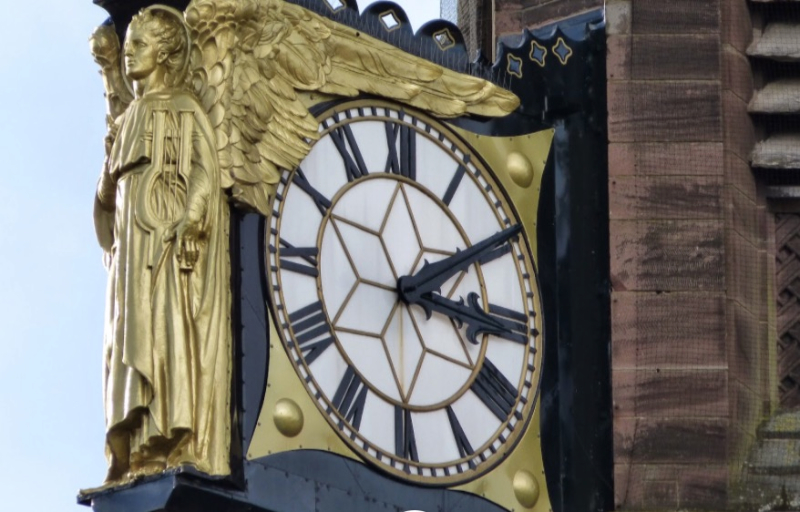
Below the clock Pepping Tom is at his window looking for Godiva; but she is over the main entrance carved in white Portland stone along with Earl of Leofric and Justice in the centre. Interestingly the Godiva statue and Justice did not go up until 1924, as Henry Wilson had not been paid and he held them back until he was. This was due to the fact that the city council had put the money to pay Henry into an account, but had spent it by the time it was due! So when King George V opened it in 1920, it was not fully finished, with two main sculptures missing!
Henry designed the seating which was made by his old friend and associate Micklewright in his Somerset workshop. This was made with Warwickshire Oak, inlaid with ebony, and carved with forest-carvings. Henry dignified the Mayor’s throne and carved the details in the Council Chamber including the Godiva and Leofric statues together with the Alderman’s benches around the front and side, with the Muses – poetry, comedy, tragedy, history in addition to the local ghost, the Veiled Nun of Polesworth.
In everyday life Wilson used his real name, ‘Harry’, only with his friends and family. The more formal sounding Henry was used for the public and his students. He was known as a great teacher and was influential at the Royal College of Art, at Central School of Art and Crafts and at the Vittoria Street School for Silversmiths and Jewellers in Birmingham. His role as Master of the Art Worker’s Guild and as President of the Arts and Crafts Exhibition Society served to confirm his significance in early 20th century design, art and education.
Some of Henry’s most amazing works of art were his great bronze doors. Below are the doors of the offices of Salada, a Tea Company in Boston. The doors tell the exotic story of the history of tea, the panel below showing the role of Sri Lanka in the tea trade.
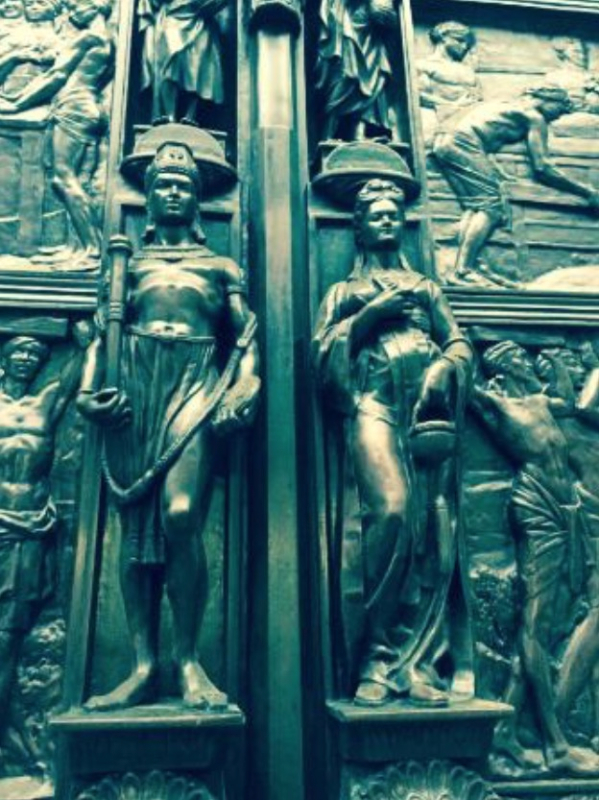
Hindu Ceylon patron deities Sundara Murthi Swami and Appar Swami
In this work he chose to show the Hindu and Singhalese people and their working lives all in bas-relief with sculpted figures on the border and above the handles. His last final great work was the bronze West doors for St. John the Divine Cathedral, New York.
Henry died on 7th March 1934 in Hotel l’Amaurite, Menton, France. He was not a rich man and wrote “I am not successful; if an artist is successful there is something wrong with his ideas. The right ideas can never be reached”.



